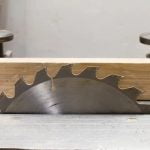Are you wondering how to fill gaps in woodworking and achieve flawless results in your projects? Mastering the art of filling gaps is a crucial skill for any woodworker, as it can significantly impact the overall aesthetics and structural integrity of the finished piece. In this comprehensive guide, we will delve into the importance of filling gaps in woodworking and provide practical tips and techniques for achieving seamless results.
When it comes to woodworking, gaps can be inevitable due to various factors such as wood movement, joinery imperfections, or natural defects in the wood itself. Understanding the common causes of gaps is essential in learning how to effectively address them and ensure a professional-looking final product. Whether you are working on small furniture pieces or large-scale construction projects, knowing how to properly fill gaps will elevate the quality of your craftsmanship.
In the following sections, we will explore different types of filler materials suitable for various gap sizes and provide a step-by-step guide on using wood filler to fill small gaps. Additionally, we will cover techniques for filling larger gaps, tips for achieving a seamless finish, proper sanding and finishing methods, as well as troubleshooting common issues that may arise during the gap-filling process.
By mastering these techniques, you can enhance your woodworking skills and produce impeccable results in your projects.
Identifying Common Causes of Gaps in Woodworking Projects
Woodworking projects often encounter the challenge of gaps, which can compromise the structural integrity and aesthetics of the final piece. Understanding the common causes of these gaps is crucial in effectively addressing and preventing them. One of the main reasons for gaps in woodworking projects is wood shrinkage and expansion due to changes in humidity and temperature. Additionally, improper joinery techniques or faulty assembly can also lead to gaps in the final product.
Another common cause of gaps in woodworking is the natural variation in wood grain and texture. This can result in uneven surfaces that create small, but noticeable, gaps. Finally, using different types of wood with varying densities and characteristics can also lead to inconsistent joints and visible gaps.
To address these issues effectively, it’s important to choose the right filler material based on the type and size of gap present in the woodworking project. Different fillers such as epoxy, wood putty, or even sawdust mixed with glue may be used depending on the specific requirements of each gap.
Properly identifying the causes of gaps in woodworking projects is essential for determining the most suitable filler material and techniques for filling them. By understanding these common causes, woodworkers can take proactive measures to prevent or minimize future occurrences of gaps in their projects.
| Cause of Gaps | Filler Material |
|---|---|
| Wood shrinkage/expansion | Epoxy |
| Natural variation in wood grain | Wood putty |
| Using different types of wood | Sawdust mixed with glue |
Choosing the Right Filler Material for Different Types of Gaps
Woodworking projects often involve dealing with gaps that need to be filled to achieve a polished and professional finish. It is essential to choose the right filler material for different types of gaps in order to ensure a seamless result. Whether you are working with small or large gaps, various filler materials can be used to address the specific needs of your woodworking project.
When considering how to fill gaps in woodworking, it’s important to identify the type and size of the gap before selecting a filler material. For small hairline cracks and pinholes, wood putty or spackling compound is an ideal choice. These fillers are easy to apply and sand down, making them perfect for minor imperfections in wood surfaces.
For larger gaps, epoxy filler or wood glue mixed with sawdust can effectively fill voids and irregularities in the wood. Epoxy fillers offer durability and strength, making them suitable for high-traffic areas or outdoor woodworking projects. On the other hand, mixing wood glue with sawdust creates a custom filler that blends seamlessly with the surrounding wood when applied and finished properly.
In addition, colored wax fill sticks can be used for filling knots and defects in wood with matching colors, providing a simple solution for achieving a cohesive appearance in your woodworking projects.
It is crucial to consider both the aesthetic and functional aspects of the filler material when choosing the right product for different types of gaps in woodworking. By understanding these options, woodworkers can effectively address any gaps in their projects and achieve professional results.
| Filler Material | Use |
|---|---|
| Wood Putty or Spackling Compound | Ideal for small hairline cracks and pinholes |
| Epoxy Filler | Effective for filling larger voids and irregularities; offers durability and strength |
| Wood Glue Mixed with Sawdust | Suitable for larger gaps; creates a custom filler that blends seamlessly when applied correctly |
| Colored Wax Fill Sticks | Great for filling knots and defects with matching colors, ensuring a cohesive appearance |
Step-by-Step Guide on Using Wood Filler to Fill Small Gaps
Wood fillers are essential in woodworking projects as they provide a seamless finish by filling in imperfections and gaps. Small gaps are common in woodwork, but with the right technique and materials, they can easily be filled to achieve a flawless result. Here is a step-by-step guide on how to use wood filler to fill small gaps in woodworking:
1. Prepare the surface: Before applying the wood filler, it’s important to ensure that the surface is clean and free of any debris or dust. Use a damp cloth to wipe the area and let it dry completely.
2. Select the right wood filler: Choose a wood filler that matches the color of your wood for a more natural look once applied. There are different types of wood fillers available, such as water-based, solvent-based, and epoxy-based fillers, so choose one that best suits your project.
3. Apply the filler: Using a putty knife or spatula, apply the wood filler into the gap, ensuring that it is slightly overfilled. Press down firmly to pack the filler into the gap and remove any excess with the putty knife.
4. Let it dry: Allow the wood filler to dry completely according to the manufacturer’s instructions. This may take anywhere from 15 minutes to several hours depending on the type of filler used.
5. Sand and smooth: Once the filler is dry, use sandpaper to carefully sand down any excess filler until it is flush with the surface of the wood. Be sure to blend it seamlessly with surrounding areas for a flawless finish.
Following these steps will help you effectively fill small gaps in your woodworking projects using wood filler, resulting in professional-looking results that enhance the overall appearance of your work.
Remember that practice makes perfect when it comes to filling gaps in woodworking projects, so don’t be discouraged if it takes some trial and error to achieve a seamless finish. With patience and attention to detail, you’ll soon master this essential technique for achieving flawless woodworking results through gap-filling techniques.
Techniques for Filling Larger Gaps in Woodworking Projects
When working on woodworking projects, it’s not uncommon to come across larger gaps that need to be filled for a seamless finish. Whether it’s due to the natural characteristics of the wood or errors during the construction process, knowing how to effectively fill these larger gaps is an essential skill for any woodworker.
Assessing the Size and Depth of the Gap
Before diving into filling larger gaps, it’s crucial to assess the size and depth of the gap to determine the best approach. Larger gaps may require different filler materials or techniques compared to smaller ones. Use a ruler or caliper to measure the dimensions of the gap and take note of its depth. This will help in selecting the appropriate filler material and guide you in determining how much filler will be needed.
Using Epoxy Resin for Large Gaps
For larger gaps that require structural support, epoxy resin is often the go-to filler material. Epoxy resin is a durable and strong adhesive that can effectively bridge large gaps in woodworking projects. It’s important to follow the manufacturer’s instructions when mixing and applying epoxy resin to ensure proper adhesion and curing. Additionally, consider adding sawdust or wood shavings to the epoxy mixture to create a color match with the surrounding wood.
Creating Custom Wood Fillers
In some cases, off-the-shelf wood fillers may not be suitable for filling larger gaps, especially if you’re working with unique or exotic wood species. To address this, you can create custom wood fillers by mixing fine sawdust with woodworking glue or shellac. This allows you to tailor the filler color and consistency to match your specific project needs. Apply the custom filler generously into the gap using a putty knife, ensuring it fills all voids completely.
Mastering techniques for filling larger gaps in woodworking projects requires patience and precision. By understanding the characteristics of different filler materials and employing proper application methods, woodworkers can achieve professional-looking results even when faced with challenging gaps in their projects.
Tips for Achieving a Seamless Finish When Filling Gaps in Wood
Achieving a seamless finish when filling gaps in woodworking projects is crucial to the overall aesthetic and structural integrity of the final piece. Whether you are working on small or large gaps, the following tips can help you achieve a flawless result.
Choose the Right Filler Material
The first step in achieving a seamless finish is to choose the right filler material for the specific type of gap you are dealing with. For small cracks and holes, wood filler or putty is typically used, while larger gaps may require epoxy resin or wood shims. It’s important to select a filler material that matches the color and grain of the wood for a natural blend once sanded and finished.
Apply Filler Carefully
When applying the chosen filler material, it’s important to do so carefully and evenly. Use a putty knife or spatula to press the filler into the gap, ensuring that it completely fills the space without leaving any air pockets. Take your time to avoid overfilling or underfilling the gap, as this will impact the final result.
Blend With Surrounding Wood
After applying the filler, take steps to blend it seamlessly with the surrounding wood. A damp cloth can be used to wipe away excess filler from the surface of the wood, while also smoothing out any rough edges. Pay attention to detail and ensure that the filled area matches the texture and contours of the surrounding wood for a seamless finish.
By following these tips, you can effectively fill gaps in woodworking projects and achieve a flawless finish that enhances both the appearance and durability of your creations.
How to Properly Sand and Finish Wood After Filling Gaps
Properly sanding and finishing wood after filling gaps is essential to achieving a flawless and professional-looking result in woodworking projects. Once you have filled the gaps in the wood, it is crucial to prepare the surface for finishing to ensure a seamless and polished appearance. In this section, we will discuss the step-by-step process of sanding and finishing wood after filling gaps.
After applying the wood filler to the gaps, allow it to dry completely according to the manufacturer’s instructions. Once the filler is dry, use a medium-grit sandpaper to lightly sand the surface of the wood, focusing on the areas where the filler was applied. This will help smooth out any rough edges or excess filler, creating a level surface for finishing.
Next, switch to a fine-grit sandpaper and continue to sand the entire surface of the wood in smooth, even strokes. Be sure to feather out the edges around the filled gaps to seamlessly blend them into the surrounding wood. This will help achieve a consistent and uniform appearance across the entire project.
After sanding, thoroughly clean away any dust or debris from the surface of the wood. You can use a tack cloth or compressed air to remove any remaining particles before applying your chosen finish. Whether you opt for stain, paint, or varnish, carefully follow its specific application instructions to ensure an even coat and professional finish.
By following these steps for properly sanding and finishing wood after filling gaps in your woodworking projects, you can achieve a flawless result that showcases your attention to detail and craftsmanship.
Troubleshooting Common Issues When Filling Gaps in Woodworking
When working on woodworking projects, it is not uncommon to encounter gaps that need to be filled. However, the process of filling these gaps can sometimes present challenges and issues that need to be addressed. In this section, we will discuss some common issues that may arise when filling gaps in woodworking and provide troubleshooting tips to help you overcome these obstacles.
One common issue when filling gaps in woodworking is the mismatch of wood filler color with the surrounding wood. This can result in a visibly patchy and uneven finish that detracts from the overall appearance of the project.
To troubleshoot this issue, it is important to carefully select a wood filler that closely matches the color and grain pattern of the wood you are working with. Additionally, you can mix different colored fillers together to create a custom shade that better blends in with the surrounding wood.
Another issue that woodworkers often encounter when filling gaps is the cracking or shrinking of the filler material over time. This can occur due to changes in humidity and temperature, as well as improper application of the filler.
To address this problem, it is essential to choose a high-quality, flexible filler material that is designed to withstand environmental changes without cracking or shrinking. Additionally, ensure that you apply the filler in thin layers and allow each layer to dry completely before applying additional coats.
Furthermore, an issue that may arise when filling gaps in woodworking is visible lines or ridges left behind after sanding the filled areas. To troubleshoot this problem, it is crucial to use a fine-grit sandpaper and sand in smooth, circular motions to blend the filled areas seamlessly with the surrounding wood surface. Taking your time and using light pressure while sanding can help achieve a flawless finish without leaving behind any visible lines or ridges.
By understanding how to troubleshoot these common issues when filling gaps in woodworking, you can ensure that your finished projects have a professional and seamless appearance. With proper technique and attention to detail, you can achieve flawless results and transform any imperfections into a beautifully finished woodworking masterpiece.
Conclusion
In conclusion, understanding the importance of filling gaps in woodworking is vital for achieving flawless results in your projects. Whether you are working on small DIY projects or larger woodworking tasks, knowing how to fill gaps effectively can make a significant difference in the overall appearance and quality of your work.
By identifying common causes of gaps, choosing the right filler material, and following step-by-step techniques for filling both small and large gaps, you can ensure that your woodworking projects have a seamless finish.
One key takeaway from this article is the importance of using the right filler material for different types of gaps. Whether you are dealing with small hairline cracks or larger voids, selecting the appropriate wood filler will help you achieve a professional-looking result. Additionally, paying attention to proper sanding and finishing techniques after filling the gaps will further contribute to a flawless appearance.
In summary, by following the tips and techniques outlined in this article on how to fill gaps in woodworking, you will be better equipped to tackle any imperfections that may arise in your projects. With practice and attention to detail, you can achieve an impeccable finish that showcases your skills as a woodworker. So next time you encounter gaps in your woodworking projects, remember these key takeaways and put them into practice to achieve outstanding results.

Hi everyone! I’m a woodworker and blogger, and this is my woodworking blog. In my blog, I share tips and tricks for woodworkers of all skill levels, as well as project ideas that you can try yourself.





